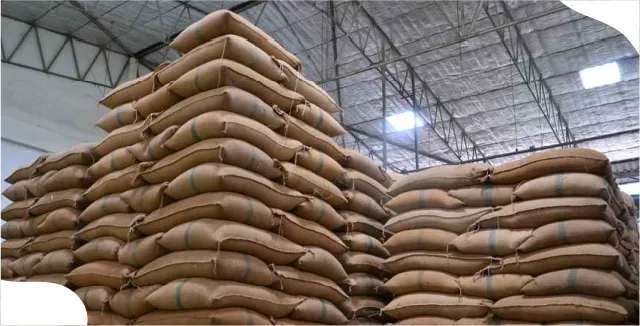
Author
LoansJagat Team
Read Time
6 Min
24 Jul 2025
What is Buffer Stock? Role, Purpose & Economic Impact
Buffer stock refers to a reserve of essential commodities, such as food grains and pulses, that the government maintains to control price fluctuations and meet emergencies. It ensures a steady supply during poor harvests, natural disasters, or sudden spikes in demand.
For example, Ramesh is a small shopkeeper in a village. During a drought year, local farmers harvest less wheat. As a result, wheat prices shoot up to ₹40 per kg from the normal ₹25. Ramesh cannot afford to buy enough wheat for his customers. Luckily, the government releases wheat from its buffer stock at a lower price.
The following example shows how buffer stock helps stabilise prices and support local sellers during emergencies.
Objectives of Buffer Stock
The main objectives of buffer stock are to maintain food security, stabilise prices, and support farmers and consumers during shortages.
The table below shows how buffer stock helps manage prices during a crisis:
Suppose the normal market price of wheat is ₹25 per kg. Due to a poor monsoon, wheat production falls, and the market price rises to ₹42 per kg. Many families cannot afford wheat at this high price.
Read More – How to Select Stocks for Intraday – Beginner to Pro Guide
To help the public, the government releases wheat from the buffer stock at ₹28 per kg through ration shops. This helps control the price in the open market and ensures people can still buy wheat at an affordable rate.
This way, the government protects consumers from high prices and ensures food remains available to all, especially in difficult times.
Buffer Stock Norms in India
The concept of buffer stock was introduced during the Fourth Five-Year Plan (1969–74). The Cabinet Committee on Economic Affairs sets minimum buffer stock norms every quarter on 1st April, 1st July, 1st October, and 1st January.
Key Points:
- The Government fixed the current norms on 22nd January 2015.
- There are two types of stocks:
- Operational Stock: For regular distribution under TPDS and Other Welfare Schemes (OWS).
- Food Security Reserves: For covering procurement shortfalls.
- Operational Stock: For regular distribution under TPDS and Other Welfare Schemes (OWS).
To understand how important this is, think about wheat. The Government maintains a strategic reserve of 30 lakh tonnes (3 million tonnes) of wheat. That’s enough to support the country during a bad harvest, price spike, or natural disaster. It keeps the supply going and prevents panic in the markets.
By planning, the Government protects both the common people and farmers from food shortages and price shocks.
- Operational stock includes food grain needs for four months; any stock above this is treated as buffer stock.
- Both stocks are stored together and are not physically separated.
- Any stock beyond the minimum norms is treated as excess and can be offloaded through:
- Open market sales
- Exports
- Extra allocation to states
- Open market sales
- The government also maintains a strategic reserve of:
- 30,00,000 tonnes of wheat
- 20,00,000 tonnes of rice
- 30,00,000 tonnes of wheat
- Since 2015, a buffer stock of 1.5 lakh tonnes of pulses has also been maintained. NAFED, SFAC, and FCI manage this procurement to control price fluctuations.
Challenges in India’s buffer stock system
1. Inefficient Inventory Management
The government should buy grains when the supply is high and release them when there is a shortage. But during a bad crop year, it not only holds back stocks for schemes like TPDS but also buys more grain. This increases demand in a supply-scarce market, pushing prices even higher.
Example:
In a poor harvest year, the wheat supply in the market drops by 20%, but the government still increases procurement by 15%. This reduces availability for private buyers and raises open market prices from ₹25/kg to ₹38/kg.
2. Rising Cost of Operation
The cost of buying and managing grains has gone up sharply due to rising MSPs, bonuses, mandi fees, milling, and administrative expenses. On average, FCI’s cost is 40% higher than the basic procurement price.
Example:
If the MSP for wheat is ₹20/kg, the actual cost to FCI, including all charges, becomes ₹28/kg. This gap widens the fiscal pressure.
3. Storage Losses and Poor Capacity
Due to limited and outdated storage infrastructure,FCI suffers huge losses. Between 2006–07 and 2011–12, storage and transit losses increased by 147% in nominal terms.
Example:
If FCI lost 1 lakh tonnes of food grain in 2006–07, it lost around 2.47 lakh tonnes in 2011–12 due to poor handling and storage.
4. De Facto Nationalisation of Grain Market
The government procures over 75% of the marketable surplus (Marketable surplus is the part of a farmer’s crop that remains after keeping enough for personal use, seeds, and animal feed. The farmer sells this surplus in the market), leaving very little for open-market buyers(Open market buyers are people or businesses who buy goods directly from the market, without any government control or subsidy. They usually pay the market price for the items). This tight supply increases open market prices, cancelling out the benefits of subsidised grain.
Example:
If the total wheat surplus is 100 lakh tonnes and the government procures 75 lakh tonnes, only 25 lakh tonnes are left for private trade, pushing prices up from ₹22/kg to ₹36/kg.
5. Fall in Per Capita Grain Availability
Despite a 29% rise in grain production between 2000 and 2012, per capita net availability fell by 1%. Hoarding large stocks lowers the actual food reaching people.
Example:
Even with total production rising from 170 million tonnes to 220 million tonnes, per person availability dropped from 180 kg/year to 178 kg/year, due to excessive stocking.
These issues suggest the need for a more balanced, transparent.
Also Read - Defensive Stocks India – Top Picks for Stable Returns
Rising Costs of Grain Management
Buffer stock ensures food security, but managing it has become expensive for the government. The cost of procurement, storage, and distribution is much higher than the MSP due to added charges.
Example: Wheat Procurement Cost
The government buys wheat at an MSP of ₹20 per kg. After adding extra costs, the total becomes ₹28 per kg.
Year-wise Cost Comparison
The increasing gap shows how buffer stock is becoming harder to manage without reforms.
To manage these rising costs, the government can take a few simple steps. It can improve storage to reduce waste, use technology to track stock better, and review the Minimum Support Price (MSP) regularly.
Conclusion
Buffer stock plays a vital role in ensuring food security, stabilising prices, and supporting both farmers and consumers. The government builds stock during surplus years and releases it during shortages to keep food affordable and available. However, high costs, poor storage, and inefficient policies affect its long-term sustainability.
To improve the system, the government must manage procurement wisely, invest in better storage, and release grains timely manner. With smarter planning, buffer stock can continue to serve its purpose without becoming a burden.
FAQ’s
1. What is buffer stock?
Buffer stock is a reserve of essential goods, like food grains, that the government stores to control prices and handle emergencies.
2. Who manages buffer stock in India?
The Food Corporation of India (FCI) mainly manages buffer stock under the Ministry of Consumer Affairs.
3. Why does the government release a buffer stock?
The government releases it during shortages to keep food prices stable and ensure supply to the public.
4. When was buffer stock introduced in India?
India introduced the buffer stock concept during the Fourth Five-Year Plan (1969–74).
5. How does buffer stock help farmers?
The government buys crops at the Minimum Support Price (MSP), helping farmers get fair prices even in surplus years.
Other Informative Pages | |||
About the Author

LoansJagat Team
‘Simplify Finance for Everyone.’ This is the common goal of our team, as we try to explain any topic with relatable examples. From personal to business finance, managing EMIs to becoming debt-free, we do extensive research on each and every parameter, so you don’t have to. Scroll up and have a look at what 15+ years of experience in the BFSI sector looks like.

Quick Apply Loan
Subscribe Now
Related Blog Post


